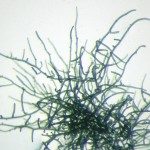Lien vers Pubmed [PMID] – 35475644
Lien DOI – e00862-2210.1128/mbio.00862-22
mBio 2022 Jun; 13(3): e0086222
Strains of the freshwater cyanobacterium Synechococcus elongatus were first isolated approximately 60 years ago, and PCC 7942 is well established as a model for photosynthesis, circadian biology, and biotechnology research. The recent isolation of UTEX 3055 and subsequent discoveries in biofilm and phototaxis phenotypes suggest that lab strains of S. elongatus are highly domesticated. We performed a comprehensive genome comparison among the available genomes of S. elongatus and sequenced two additional laboratory strains to trace the loss of native phenotypes from the standard lab strains and determine the genetic basis of useful phenotypes. The genome comparison analysis provides a pangenome description of S. elongatus, as well as correction of extensive errors in the published sequence for the type strain PCC 6301. The comparison of gene sets and single nucleotide polymorphisms (SNPs) among strains clarifies strain isolation histories and, together with large-scale genome differences, supports a hypothesis of laboratory domestication. Prophage genes in laboratory strains, but not UTEX 3055, affect pigmentation, while unique genes in UTEX 3055 are necessary for phototaxis. The genomic differences identified in this study include previously reported SNPs that are, in reality, sequencing errors, as well as SNPs and genome differences that have phenotypic consequences. One SNP in the circadian response regulator rpaA that has caused confusion is clarified here as belonging to an aberrant clone of PCC 7942, used for the published genome sequence, that has confounded the interpretation of circadian fitness research. IMPORTANCE Synechococcus elongatus is a versatile and robust model cyanobacterium for photosynthetic metabolism and circadian biology research, with utility as a biological production platform. We compared the genomes of closely related S. elongatus strains to create a pangenome annotation to aid gene discovery for novel phenotypes. The comparative genomic analysis revealed the need for a new sequence of the species type strain PCC 6301 and includes two new sequences for S. elongatus strains PCC 6311 and PCC 7943. The genomic comparison revealed a pattern of early laboratory domestication of strains, clarifies the relationship between the strains PCC 6301 and UTEX 2973, and showed that differences in large prophage regions, operons, and even single nucleotides have effects on phenotypes as wide-ranging as pigmentation, phototaxis, and circadian gene expression.

